Site menu:
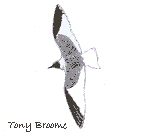
November 2017 Newsletter
Book Review: Rare and Scarce Birds in C&W.
Colour Ring Report.
October Bird News.
Forthcoming Events.
Latest Newsletter.
Review:
Rare and Scarce Birds of Cheshire & Wirral
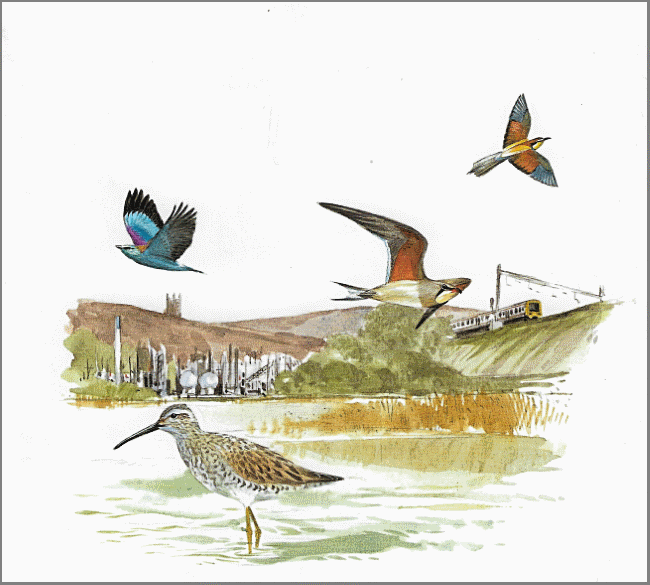
The Rare and Scarce Birds
of Cheshire & Wirral
by Allan Conlin and Eddie Williams has now been published. It is
available at the Reception Hide at RSPB Burton Mere Wetlands, at the
Focalpoint Optics shop (close to junction 10 of M56 - see www.fpoint.co.uk),
or by
post. The cost
is £24.99 + £3.95 P&P, to order please email rarebirdingwirral@gmail.com.
This is 248 pages of delight for all birders with an interest in the birds of Cheshire and Wirral and many of you will know the authors who, being keen local birders and well known finders of some mega rarities themselves, are well qualified to write such a book.
North Wirral is internationally famous as the best place in Europe to see Leach's Petrel and it is certainly appropriate that the first chapter in the book is about Sea-watching. The second chapter is a fascinating look at the changing status of several species including Cattle Egret and Yellow-browed Warbler, which is followed by a Site Guide detailing the most important sites in Cheshire and Wirral. The bulk of the book, of course, is the comprehensive Species Accounts. I love that the authors have included so many scarce birds as well as the rarities, so, for example, we have accounts of both Balearic Shearwater and Leach's Petrel, of Western Sandpiper and Grey Phalarope, of Radde's Warbler and Firecrest. This makes the book a much more rounded and comprehensive read. Included with the species accounts are various Finder's Accounts and these are perhaps the most interesting parts of the book giving an insight into what it takes to find a mega-rarity - dedication, expertise, perseverance, luck.................
I end, with
permission of the authors, with two short extracts. The first a site
guide to an area much loved by the authors, and the second the Sooty
Shearwater account which I though appropriate after one was seen in
September (2017) during the gales.
Site Guide
Meols to Leasowe.
This
is a large area consisting of a variety of habitats running alongside
and inland from the coastal embankment, roughly from Dove Point, Meols,
to the bottom of Pasture Road, Leasowe. This area is often just
called 'Leasowe’ or 'Leasowe Lighthouse'. It is a great catchment area
for migrants in spring and autumn and has produced a lengthy list of
rarities over the years. Unlike further west at Red Rocks,
migrants can be seen here throughout the day with many arrivals being
noted during the afternoon.
Sea-watching from the coastal
embankment can be productive, especially during strong onshore winds in
autumn. A selection of rare seabirds such as all four skuas, Sabine's
Gull, Leach's and Storm Petrel's, Grey Phalarope and Sooty
Shearwater can be seen in these conditions although there is less
shelter here than at other local sea-watching sites such as Hilbre
Island or New Brighton. The mudflats and tidal channels are also
worth scanning as there is always a chance of a rare wader. Red-necked
Phalarope and American Golden Plover have been seen here.
The
Meols Common area, consisting of coastal dunes, runs alongside the
embankment from Dove Point east to a large area of horse paddocks. The
famous 1979 Asian Desert Warbler occurred here near the coastguard
building. Other past rarities recorded here have included Wryneck,
Little Bunting and Serin.
Inland
from Meols Common and the coastal paddocks lies Park Lane. This runs
eastwards from Bennett's Lane, Meols, to meet the large area of horse
paddocks mentioned above. This tree- and shrub-lined road affords great
views into the bordering fields and market gardens and attracts good
numbers of migrants. White Stork, Pectoral Sandpiper, Alpine Swift,
Red-rumped Swallow and Red-backed Shrike have been recorded in this
area...................
The site guide continues to describe the area where the horse paddocks are, around the Leasowe Lighthouse and down Lingham Lane.
SOOTY SHEARWATER Puffinus griseus
Scarce visitor. The commonest of the larger shearwaters in our area but of infrequent occurrence none the less.Sooty Shearwaters breed in the south
Pacific and south Atlantic on
small islands. Their main breeding range is around New Zealand, Tierra
del Fuego, the Auckland
Islands, Philip Island and the Falklands. They undergo a spectacular
migration at the end of their
March-May breeding season, taking a circular route north up the western
sides of the Pacific
and Atlantic oceans reaching subarctic waters in June-July. They then
cross from west to east and
return south down the eastern sides of both oceans in September-October
before the majority reach
their breeding areas in November.
The infrequent appearances of this species off our coastline is usually
linked to the presence of strong onshore winds in autumn, ideally with
a north-westerly
direction. Even during these conditions, however, sightings are in no
way assured and the species
is far from annual in occurrence. The first county record was of a bird
seen at close range off Hilbre
Island by at least five observers on 13th September1958, the
description of which satisfied A. W. Boyd, to
whom the record was sent (8). A notable record was that of four birds
seen off Hilbre Island
by J. D. Craggs & J. C. Gittins on 21st August 1965. Peak
numbers since that date include eight sightings in
1985 and five each in 1978 and 1984.
There have been no reports to date for 2106.
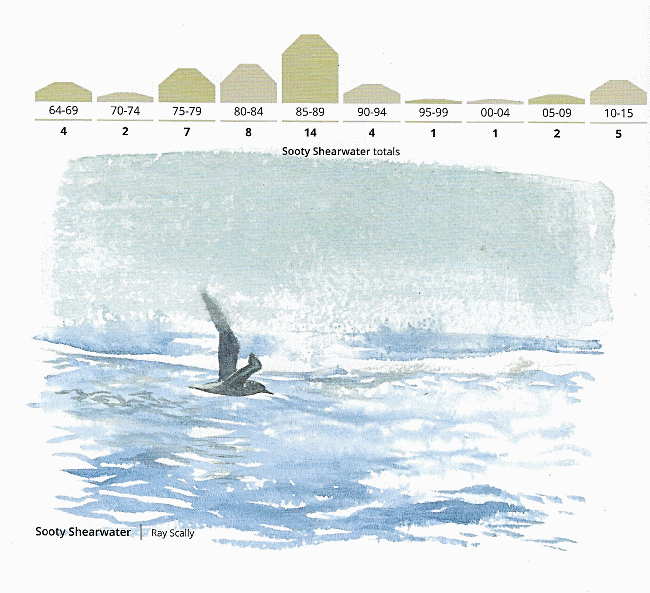
Top of Page
Colour Ring Report
In terms of numbers recorded, it has been a
record breaking few weeks for colour-ringed (CR) birds including a
remarkable 95 knots. But we've also seen a good selection of other CR
birds including oystercatchers. Since our little group have
been
logging the CRs, at least 12 years now, we've only seen a total of 10
Oystercatchers, amazingly six of those have been recorded in these past
six weeks! With so many CR birds seen I can only give a few highlights,
as follows:
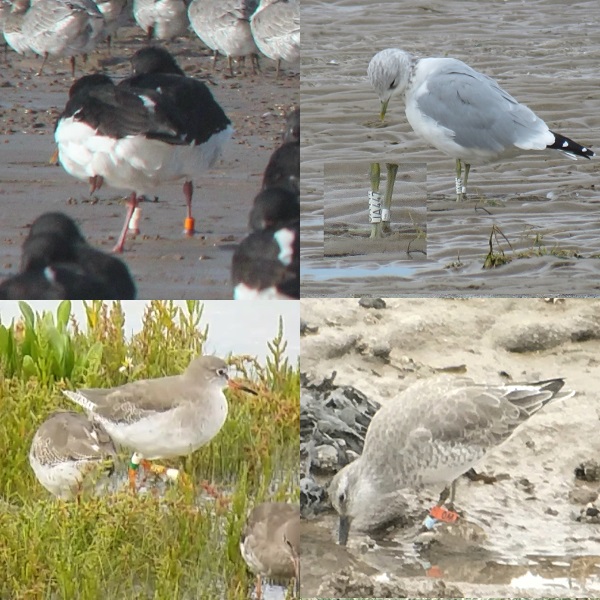
Oystercatchers
WW-GflagO - the Gflag, which should be on the right tibia, was missing, same as one we saw last winter. Apparently the birds can get these off! (To read about the study into Icelandic breeding Oystercatchers see my article).
Ringed as incubating adult in SW
Iceland on May 27th 2015.
Recorded on Hoylake shore 20th and 22nd October 2017.
Also seen in Iceland close to ringing site in April 2016 and March and
April 2017.
No other records outside Iceland.
Quite a few of our Oystercatchers have been ringed as breeding birds or chicks in north-east Scotland where there are two ringing groups - Grampian and Tay. We've seen three over the past few weeks, this one being typical:
T26
(on yellow ring on left tarsus).
Ringed
with metal ring as an adult in Ballater, Aberdeenshire, on April 1st
2012, then ringed with colour ring (T26) at the same location on March
29th 2014.
Recorded on Hoylake Shore on September 21st 2017.
Also sighted at Glen Cairn in June 2014, and in the river roost at
Ballater in March 2015 and March 2017.
Common Gull
JA447
(black on white ring).
Ringed as a breeding adult at Skranevatnet, near Bergen, Norway, on
June 5th 2016.
Recorded on Hoylake Shore on August 19th 2016 and October 9th 2017.
Knots
See last
month's Ringing Report for details of the Orange flagged
knots and the project studying Knots in the north-west estuaries.We continue to record these knots, below is a summary.
Total Orange flagged not recorded up to 31st October:
Caldy Wildfowl Collection - 78
Thurstaston Shore - 10
Plus a further 3 at both Caldy and Thurstaston
Hilbre - 1 (see photo of "OM" above)
Hoylake Shore - 1
Making a total of 93, 18% of the birds ringed on Sep 22nd at Altcar.
Plus there have been 45 sightings of
these birds at Crosby and Formby Point, demonstrating just how much
movement there is between the sites.
Redshanks
We don't see many colour-ringed Redshank but two were recorded over the past two months, both ringed near Cardiff. Here are details of the one in the photo:R//YW-WG.
Ringed at Peterstone (east of Cardiff) on December 13th 2015.
Recorded on Oakenholt Marsh on September 21st 2017.
Also recorded in Rhymney mouth (east of Cardiff in January 2016.
Dunlins
Orange ring (left) - Orange flag (right) - flag was inscribed with letters but we were unable to read it, the bird was a juvenile. Here is the response from the ringer:The field season at Longyearbyen, Svalbard, failed this year. It was very late and not good breeding. Only 5 juveniles were flagged !! All of them near Longyearbyen. The distance Longyearbyen-Hoylake is 2857 km . The 5 birds were flagged in the period 09.08-21.08.2017.
O-Y(X16) - photo below.
Ringed as a juvenile on passage on September 20th 2017 at Ynyslas NNR, near Aberystwyth, Wales.
Recorded on Heswall Shore on September 22nd 2017.
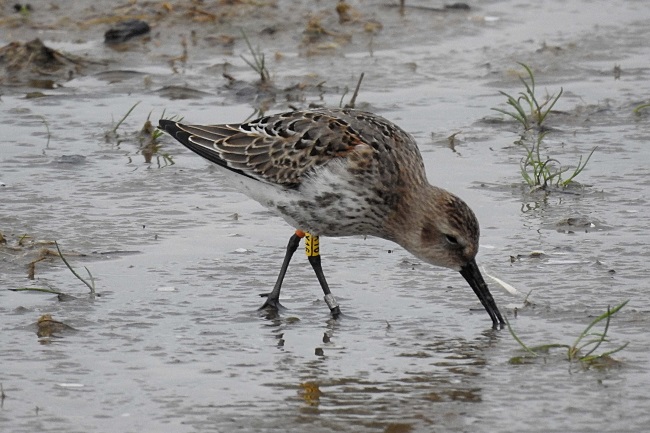
Richard
Smith.
Colour-rings were also recorded by Matt Thomas, Steve
Hinde, Peter Haslem, Richard Beckett, Paul Ralston, Alan Hitchmough,
Les Hall, Jane Turner and Elliot
Montieth.
October Bird News
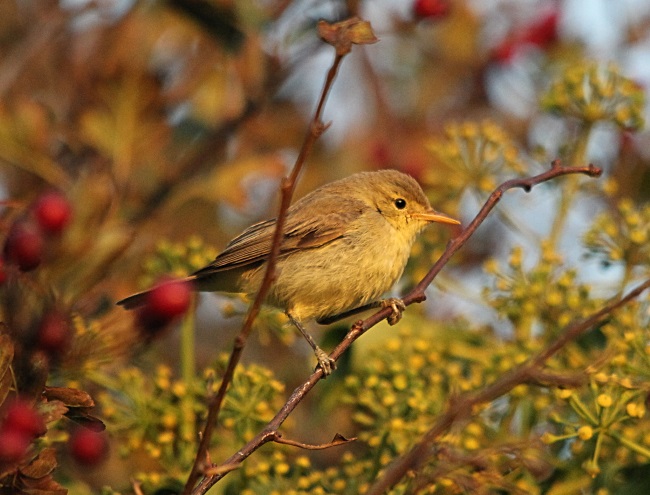
What a fabulous month. The remnants of hurricane Ophelia was followed
by storm Brian which in turn was followed by at least two more days of
strong winds, all of which made for some great sea-watching. But in
between these storms we had some beautiful quiet, often sunny, days
making for some very pleasant birding particularly watching raptors,
owls, egrets, geese etc over and on the marshes. Then there were the
rarities.
The Pallid Harrier (first for Cheshire and Wirral) which was spotted at the end of September remained for two more days and there were a further three reports through the month. A Pectoral Sandpiper was at Burton Mere Wetlands on the 4th. A Sooty Shearwater during the storms on the 5th gave great views to a lucky few at Wallasey. Four records of Yellow-browed Warblers was back to more normal numbers after last year's influx and a Rose-coloured Starling was at Connah's Quay on the 16th. There was a very late record of a Melodious Warbler on October 29th at Lingham Lane, the first for Cheshire and Wirral since 1995. These are nearly always found on the coast and all previous records for our area were either on Hilbre or at Red Rocks.
To record Leach's Petrels on nine days in October was excellent, max 18 at Hilbre on the 5th. We also had Sabine's Gulls, Black Terns, Pomarine, Long-tailed, Arctic and Great Skuas and three more Grey Phalaropes to add to the 2017 total after an exceptional September.
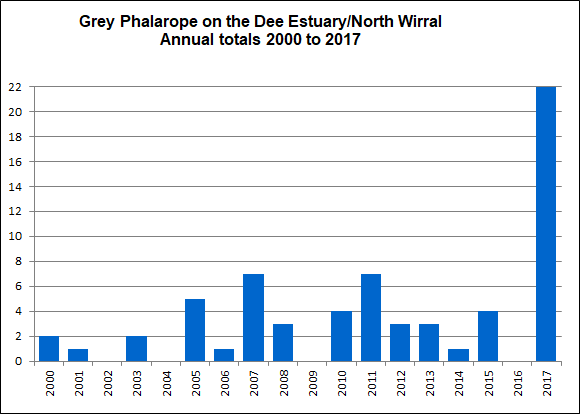
This autumn we haven't had the massive flocks of Common Scoter seen in recent years, but 7,000 on the 2nd wasn't bad!
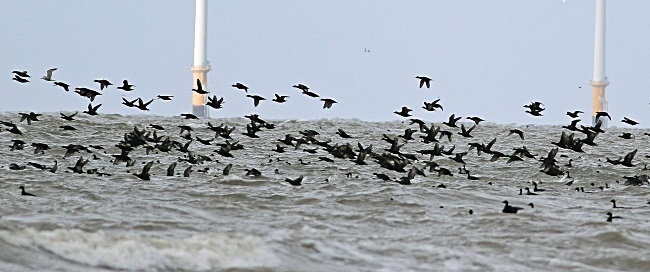
https://elliotsbirdingdiaries.wordpress.com/
Just how many Marsh Harriers we've had on the estuary I'm not sure but,
given the number of records received, the count of 10 counted coming
into roost on the 17th was not totally unexpected. There are at least
four Hen Harriers on the marshes including a grey male. It looks like
it's going to be a good winter for Short-eared Owls with several counts
of six and one of seven. At least one Cattle Egret has been at Burton
Mere Wetlands all month and there have been counts of nine Great White
Egrets at both Neston and Heswall.
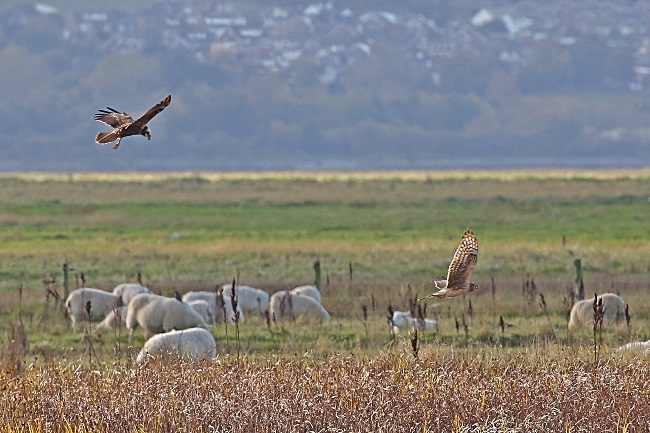
Top of Page
What to expect in November
Knot numbers usually increase to around 10,000 plus this month. With an increase in the number that have been ringed this year it will be interesting to see where these have come from. It will be good to see returning Purple Sandpipers with birds both at Hilbre and New Brighton. The first Snow Buntings of the winter may well be spotted along the coast.
If we get some calm weather look on the sea for Red-throated Divers, perhaps as many as a hundred or more, and several hundred Great Crested Grebes. November can also bring a massive influx of Herring Gulls and we've had around 20,000 in the past on East Hoyle Bank.
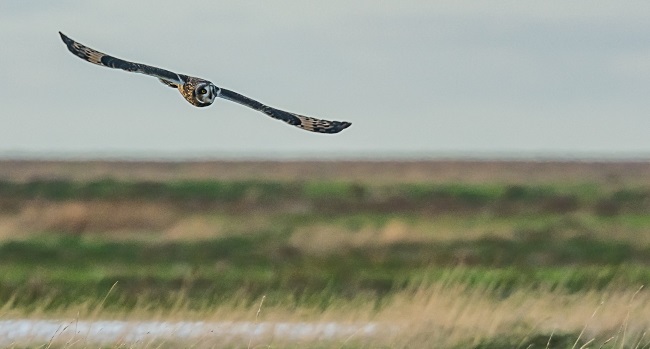
Top of Page
Forthcoming Events
November Highest Spring Tides (Liverpool)
Also
see Tides
page.
4th November, 10.47hrs (GMT), 9.7m.
5th November, 11.27hrs (GMT), 9.9m.
6th November, 12.10hrs (GMT), 9.9m.
7th November, 12.54hrs (GMT), 9.7m.
Forthcoming Events
Organised by the Wirral
Ranger Service , Flintshire
Countryside Service and the
RSPB (Dee Estuary):
All these events and walks have bird interest, even those not
advertised specifically for birdwatching. No need to book for these
events unless specified - please check below.
10am-3pm
Price: Free
High tide on 5th Nov is 11.27hrs (9.9m) and on 6th Nov is 12.10hrs (9.9m). Best to arrive at least an hour before high tide to watch the birds being pushed in by the tide.
Come
along to the Old Baths car park for chance of seeing a range of birds
of prey hunting over Parkgate Marsh. Harriers, peregrines and merlins
are all returning to the estuary for the winter and this is one of the
best places to watch, plus short-eared owls if we're really lucky.
The big tides on these days should push things in
close. Also
chance of seeing a range of ducks, geese, wading birds and egrets as
their flocks build on the estuary for the winter.
There is free
public parking at the Old Baths car park (CH64 6RN) at the north end of
The Parade, and the Wirral Country Park car park on Station Road (CH64
6QJ). There are public toilets at Mostyn Square in the middle of The
Parade, and a number of pubs and cafes.
Directions:
Old Baths car park, Boathouse Lane/The Parade (B5135), Parkgate,
Neston, Cheshire.
For further details ring: 0151 353 8478.
Saturday 18th
November, Dusk Chorus at Burton
Mere Wetlands.
3-5pm
Price: £8 per person (RSPB members £6.50)
Booking essential,
ring: 0151 353 8478.
We're
all familiar with the dawn chorus, but have you ever stopped to listen
to the sounds of the countryside as the sun goes down? Honking geese,
whistling waders and chattering jackdaws soundtrack peaceful sunsets at
Burton Mere Wetlands, with one of the country's largest egret colonies
returning from the marsh, and a small starling murmuration over the
reedbed.
Join us for a late afternoon guided walk as the
temperature drops and the birds start to prepare for another long
night, returning as the light fades and many birds return to Burton
Mere Wetlands to roost. Finish with a hot drink back in Reception Hide
and chance of seeing a barn owl emerging to hunt.
Places are limited, so advanced booking and payment are essential.
8.30-10.30am
Price: £8 per person (RSPB members £6.50)
Booking essential, ring: 0151 353 8478.
The UK's wetlands are a vital winter home for thousands of wading birds and wildfowl, and the Dee Estuary is one of the best places in the country to see them. Join an experienced guide for a morning walk around Burton Mere Wetlands to brush up on your ID of the various waders, ducks, geese and swans that spend the winter here.
There's also a great chance of seeing a range of birds of prey including harriers and peregrines, plus impressive flocks of finches and buntings in the sacrificial crop fields, whilst kingfishers have been very active this autumn.
The walk will stick to the reserve's normal trails which are mostly hard-surfaced, but the outer reaches of the reserve have natural paths and a couple of sets of steps to reach the Inner Marsh Farm hide. Warm up back at the Reception Hide with a hot drink and a chance to see what may have been pushed in from the saltmarsh by the rising tide.